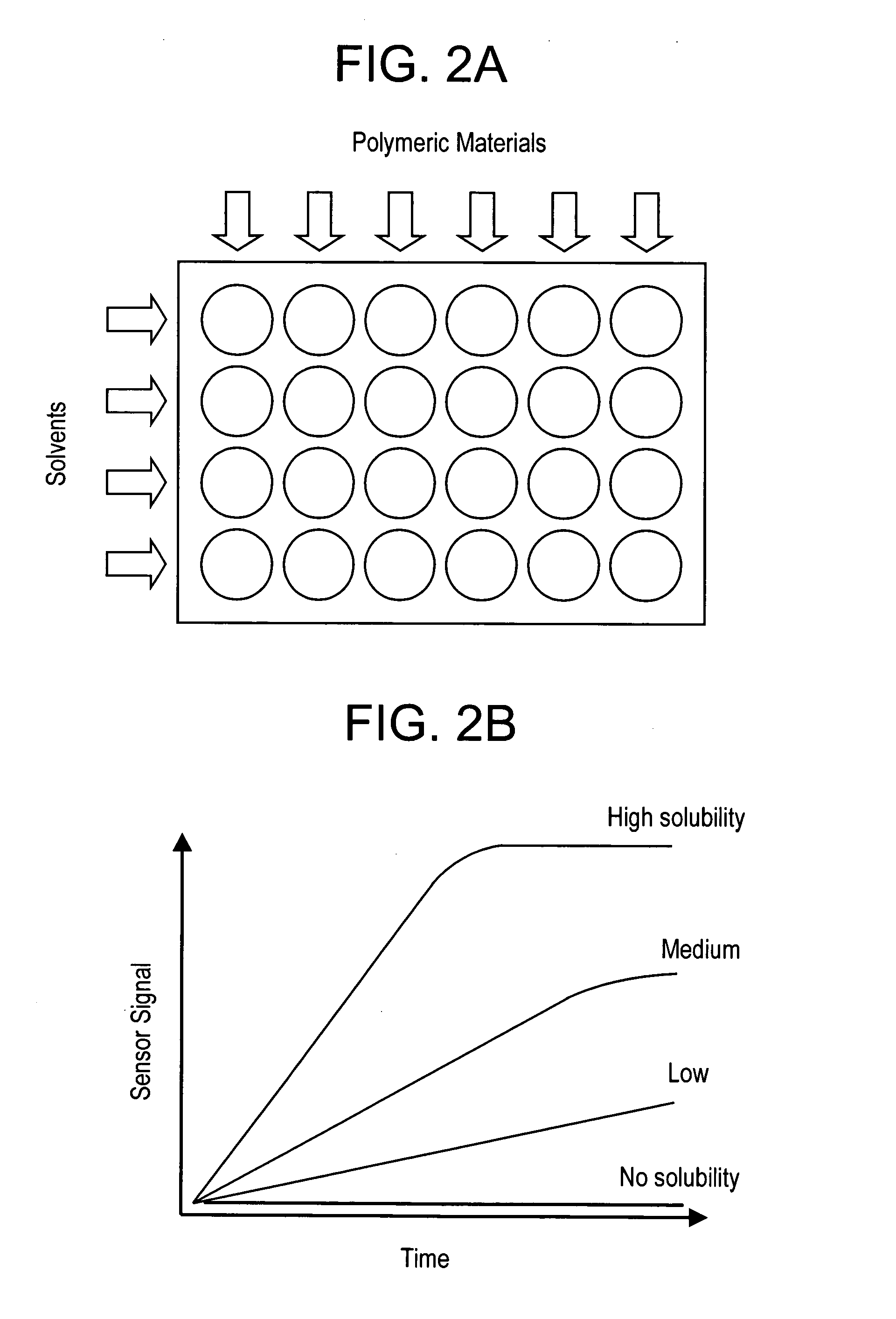Sensor devices containing co-polymer substrates for analysis of chemical and biological species in water and air
a technology of co-polymer substrates and sensors, applied in chemical methods analysis, material electrochemical variables, instruments, etc., can solve the problems of adversely affecting the analytical capacity of the sensor, affecting the substrate during sensor deposition, and common with the use of solvents
- Summary
- Abstract
- Description
- Claims
- Application Information
AI Technical Summary
Benefits of technology
Problems solved by technology
Method used
Image
Examples
example 1
[0079] Polycarbonate copolymers were used as advanced polymeric substrates for sensor applications. Compositions of these copolymers included hydroquinone, methylhydroquinone, bisphenol-A, and biphenol. A 24-channel acoustic-wave sensor system, as disclosed in U.S. patent application Ser. No. 2002 / 0172620 was utilized for the evaluation of the solubility of these polymers by solvents of interest. The system permitted rapid determination of minute quantities of material deposited onto the surface of a thickness-shear mode (TSM) sensor from a solvent containing a polymer of interest. A crystal was exposed to a polymer / solvent combination and a residual dissolved material was quantified after sensor removal and solvent evaporation. As the mass increase of the crystal is proportional to the amount of dissolved material, mass increase mF may be detected as the change in the oscillation frequency ΔfF of the sensors utilizing the following equation:
ΔfF=−202(mF / A)(μQ ρQ)−1 / 2,
where f0 is ...
example 2
[0085] This example compared polycarbonate copolymers and BPA polycarbonate as sensor substrates. The effects of solvents used for preparation of sensor regions was compared for different sensor substrates. Sensor substrate materials and the ratio of their components (by mol %) are set forth below in Table 2. The solvents utilized were chloroform and THF.
TABLE 2Types of studied sensor substrates.Material #Description / mol % of componentsAOQ1020CBPC 104CPC134D30 / 20 / 50 HQ / RS / BPAE80 / 20 MeHQ / BPAFGlass slide
OQ1020C is an optical grade polycarbonate obtained from GE Plastics, Spain, with a Molecular Weight of about 18,000.
PC 104 and PC 134 are polycarbonates obtained from GE Plastics, The Netherlands, with Molecular Weights of about 30,000 and 35,000, respectively.
MeHQ = methylhydroquinone; BPA = bisphenol-A; HQ = hydroquinone
[0086] The comparison was done by the formation of two types of sensor regions. The first type was made by depositing a solution of nile red in chloroform (10 mi...
example 3
[0092] This experiment analyzed applications of polycarbonate copolymers as sensor substrates. Quantitative detection of chemical species using advanced polymeric substrates was achieved with an optical-based sensor system. The system, described above in Example 2, contained a portable white light source, a spectrometer, and a bifurcated fiber-optic bundle.
[0093] Detection of pH was performed by dissolving cellulose acetate and bromothymol blue in methyl ethyl ketone (MEK) and depositing the solution of this polymer and reagent onto a surface of an Izod bar made from material #2 (see Table 1 above). The film was produced by evaporation of the solvent at room temperature for several hours followed by baking at 80° C. for one hour. The Izod bar with a deposited sensor region was then immersed in a solution having varying levels of pH adjusted with NaOH or HCl with concentrations produced by adding known amounts of stock solutions of analyte. pH was adjusted by adding dropwise 100 mic...
PUM
| Property | Measurement | Unit |
|---|---|---|
| thickness | aaaaa | aaaaa |
| thickness | aaaaa | aaaaa |
| temperature | aaaaa | aaaaa |
Abstract
Description
Claims
Application Information
 Login to View More
Login to View More - R&D
- Intellectual Property
- Life Sciences
- Materials
- Tech Scout
- Unparalleled Data Quality
- Higher Quality Content
- 60% Fewer Hallucinations
Browse by: Latest US Patents, China's latest patents, Technical Efficacy Thesaurus, Application Domain, Technology Topic, Popular Technical Reports.
© 2025 PatSnap. All rights reserved.Legal|Privacy policy|Modern Slavery Act Transparency Statement|Sitemap|About US| Contact US: help@patsnap.com



